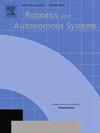实现基于接触的人机物理交互之路
IF 5.2
2区 计算机科学
Q1 AUTOMATION & CONTROL SYSTEMS
引用次数: 0
摘要
随着人机交互技术(HRI)的发展,机器人现在能够近距离操作,并与人类进行物理交互(pHRI)。同样,基于接触的 pHRI 也越来越常见,因为机器人配备了一系列传感器来感知人类的动作。尽管有一些调查对人机交互和 pHRI 的各个方面进行了探讨,但目前在收集、整理和关联接触式 pHRI 各个方面发展的综合研究方面还存在空白。要全面了解该领域的现状,深入分析已涉及的各个方面,并确定需要进一步关注的领域,这已成为一项挑战。因此,本调查报告应运而生。本调查包括 pHRI 领域的主要发展,重点关注基于接触的交互,这种交互在工业、康复和医疗机器人领域有大量应用。在所有文献中,一个共同点是建立安全、顺应和以人类意图为导向的交互非常重要。这项工作包括感知、规划和控制等方面,以及它们如何协同工作以提高安全性和可靠性。值得注意的是,调查强调了数据驱动技术的应用:越来越多的文献证明了数据驱动技术的有效性,强化学习和从演示中学习等方法已成为在复杂和不确定的 pHRI 场景中改进机器人感知和决策的关键。这项调查还强调,人们对 pHRI 的伦理考虑,包括开发适合人类和社会的接触式 pHRI 系统的关注还很不够。由于该领域尚处于早期阶段,这些观察结果可能有助于指导未来的发展,并引导研究将物理交互机器人以负责任的方式融入工作场所、公共空间和私人生活中。本文章由计算机程序翻译,如有差异,请以英文原文为准。
The path towards contact-based physical human–robot interaction
With the advancements in human–robot interaction (HRI), robots are now capable of operating in close proximity and engaging in physical interactions with humans (pHRI). Likewise, contact-based pHRI is becoming increasingly common as robots are equipped with a range of sensors to perceive human motions. Despite the presence of surveys exploring various aspects of HRI and pHRI, there is presently a gap in comprehensive studies that collect, organize and relate developments across all aspects of contact-based pHRI. It has become challenging to gain a comprehensive understanding of the current state of the field, thoroughly analyze the aspects that have been covered, and identify areas needing further attention. Hence, the present survey. While it includes key developments in pHRI, a particular focus is placed on contact-based interaction, which has numerous applications in industrial, rehabilitation and medical robotics. Across the literature, a common denominator is the importance to establish a safe, compliant and human intention-oriented interaction. This endeavour encompasses aspects of perception, planning and control, and how they work together to enhance safety and reliability. Notably, the survey highlights the application of data-driven techniques: backed by a growing body of literature demonstrating their effectiveness, approaches like reinforcement learning and learning from demonstration have become key to improving robot perception and decision-making within complex and uncertain pHRI scenarios. This survey also stresses how little attention has yet been dedicated to ethical considerations surrounding pHRI, including the development of contact-based pHRI systems that are appropriate for people and society. As the field is yet in its early stage, these observations may help guide future developments and steer research towards the responsible integration of physically interactive robots into workplaces, public spaces, and elements of private life.
求助全文
通过发布文献求助,成功后即可免费获取论文全文。
去求助
来源期刊

Robotics and Autonomous Systems
工程技术-机器人学
CiteScore
9.00
自引率
7.00%
发文量
164
审稿时长
4.5 months
期刊介绍:
Robotics and Autonomous Systems will carry articles describing fundamental developments in the field of robotics, with special emphasis on autonomous systems. An important goal of this journal is to extend the state of the art in both symbolic and sensory based robot control and learning in the context of autonomous systems.
Robotics and Autonomous Systems will carry articles on the theoretical, computational and experimental aspects of autonomous systems, or modules of such systems.
 求助内容:
求助内容: 应助结果提醒方式:
应助结果提醒方式:


